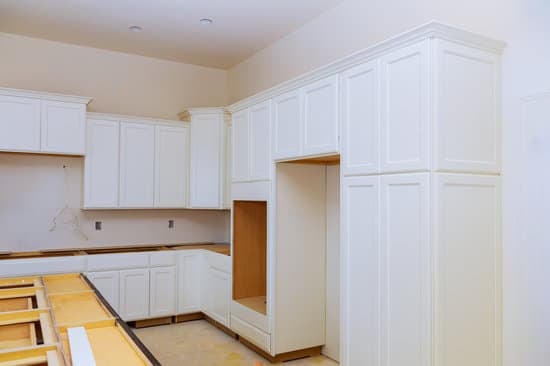The key to a successful home improvement project is careful planning and organization. In this article, we will discuss how to make a home improvement list, a crucial step in ensuring that all necessary tasks are identified and completed in an efficient manner. From assessing your home to establishing priorities, setting a budget, creating a timeline, and staying organized, we will guide you through the process of building a comprehensive home improvement list.
A home improvement list is essentially a roadmap for your projects, outlining all the tasks that need to be completed to enhance your living space. It serves as a valuable tool for homeowners who want to efficiently manage their renovation or maintenance projects, whether big or small. By breaking down the tasks into manageable steps and prioritizing them, you can ensure that nothing gets overlooked and that your time and resources are used effectively.
By creating a home improvement list, you can tackle projects in a systematic way while also ensuring that essential tasks are addressed promptly. This not only helps to keep your home in good condition but also increases its value over time. With this in mind, let’s dive into the details of how to create an effective home improvement list and why it’s an essential aspect of maintaining and improving your home.
Assessing Your Home
Before you start any home improvement project, it’s important to assess your home to determine what areas need attention. One way to do this is by taking a walk through each room and making note of things that need fixing or updating.
This could include anything from outdated paint colors to a leaky faucet or an old HVAC system. By going through each room meticulously, you can get a clearer picture of the scope of work that needs to be done.
Another aspect of assessing your home for improvement projects is to consider the functionality of the space. Are there any areas in your home that are underutilized? Are there storage solutions that could be improved? Taking note of these details will help you prioritize which projects are most important and how they can improve the livability of your home.
In addition, it’s also important to assess the energy efficiency and safety of your home. Are there any drafty windows or doors? Do you have any outdated electrical wiring that needs upgrading? These kinds of assessments will not only improve the comfort and safety of your home but can also save you money on utility bills in the long run.
| Aspect | Consideration |
|---|---|
| Functionality | Identify underutilized spaces and storage solutions |
| Energy Efficiency | Evaluate potential drafts and outdated insulation |
| Safety | Check for hazards such as outdated wiring or fire hazards |
Establishing Priorities
When it comes to making a home improvement list, one of the most crucial steps is establishing priorities. Determining which home improvement projects are most urgent or important can help you focus your time and resources on the areas that need attention the most. Here are some key sub-sections to consider when determining your priorities.
Evaluating Needs vs. Wants
One of the first steps in establishing priorities for your home improvement list is distinguishing between needs and wants. Assess which projects are essential for the safety, functionality, and efficiency of your home, versus those that are more aesthetic or optional. This will help you prioritize critical improvements over less pressing ones.
Considering Return on Investment
Another factor to consider when prioritizing home improvement projects is their potential return on investment (ROI). Certain renovations, such as kitchen or bathroom upgrades, can significantly increase the value of your home. It’s important to weigh the long-term benefits of each project against its upfront cost.
Assessing Urgency
Some home improvement projects may be time-sensitive due to issues like water damage, structural problems, or safety hazards. These types of projects should take top priority on your list in order to prevent further damage or risks to your family and property. By assessing urgency, you can ensure that critical repairs are addressed promptly.
By carefully evaluating your needs versus wants, considering ROI, and assessing urgency, you can determine which home improvement projects should take precedence on your list. This strategic approach will help you make the most efficient use of your time and resources while improving your home.
Setting a Budget
Creating a budget for your home improvement projects is essential to ensure that you don’t overspend and that your projects are financially feasible. Here are some tips for creating a realistic budget for your home improvement list.
Assess the Scope of Your Projects
Before you can establish a budget, you need to have a clear understanding of the scope of each project on your home improvement list. Take the time to carefully assess what needs to be done for each project, including any necessary materials, labor, and potential unexpected expenses.
Research Costs
Once you understand the scope of your projects, it’s important to research the costs associated with each one. This includes getting estimates from contractors, comparing prices for materials at different stores, and factoring in any additional costs such as permits or disposal fees. Having a clear understanding of the costs involved will help you create an accurate budget.
Consider Contingency Funds
When creating your budget for home improvements, it’s essential to include a contingency fund for unexpected expenses. As much as we try to plan for every detail, there are often unforeseen costs that arise during renovations. By setting aside a contingency fund, you can handle these surprises without blowing your budget.
By following these tips and taking the time to carefully consider all aspects of your home improvement projects, you can create a realistic budget that will help guide your efforts and keep your finances in check.
Researching Contractors and Materials
When it comes to home improvement projects, finding the right contractors and materials is crucial to the success of your endeavors. Researching contractors and materials for your projects can seem like a daunting task, but with the right approach, it can be a manageable and even enjoyable part of the process.
One of the first steps in finding reputable contractors is to ask for recommendations from friends, family, or neighbors who have had similar work done on their homes. Getting personal referrals can help you find trustworthy professionals who have already proven their skills and reliability. Additionally, you can look online for reviews and ratings of local contractors to get a better understanding of their track record and reputation.
As for sourcing quality materials, it’s important to do your homework. Take the time to research different options and compare prices, quality, and durability. Look for materials that have good warranties and positive customer reviews. Visiting local hardware stores or material suppliers can also give you a chance to see and touch different products before making a decision.
Furthermore, don’t hesitate to ask potential contractors about their preferred materials and suppliers. A reliable contractor will be transparent about where they source their materials from and should be able to provide you with information about the quality of those materials. By taking the time to research contractors and materials thoroughly, you’ll set yourself up for successful home improvement projects that will stand the test of time.
Creating a Timeline
First, prioritize your projects based on urgency and complexity. Start by identifying which projects are the most pressing and work your way down the list. This will help you determine the order in which the projects should be tackled and how much time each one will likely take.
Next, consider any external factors that may impact your timeline, such as weather or contractor availability. For example, if you plan to do outdoor renovations, you’ll need to take into account seasons and weather conditions that may affect the project.
Once you have identified the order of your projects and taken external factors into consideration, it’s time to create a detailed timeline. Break down each project into smaller tasks and estimate the amount of time each task will take. This will give you a clear picture of how long each project will realistically take to complete.
By following these tips, you can effectively create a timeline for your home improvement list that helps you stay organized and on track with your projects. With careful planning and organization, you can ensure that your home improvement projects are completed in a smooth and efficient manner.
| Tips for Creating a Timeline | Description |
|---|---|
| Prioritize Projects | Identify urgent and important projects for the order they should be tackled |
| Consider External Factors | Take into account weather conditions and contractor availability that may affect the timeline |
| Create Detailed Timeline | Break down each project into smaller tasks and estimate time needed for each task |
Making a Detailed Plan
Once you have assessed your home, established priorities, and set a budget for your home improvement projects, the next step is to create a detailed plan for each project. Having a clear and thorough plan in place will help you stay organized, manage your time effectively, and ensure that each project is completed successfully. Here are some tips for outlining each project step by step:
- Start by making a list of all the tasks that need to be completed for each project. Break down each task into smaller, manageable steps.
- Consider the order in which tasks should be completed. Some tasks may need to be done before others can begin, so it’s important to prioritize and sequence them accordingly.
- Research any specific techniques or materials that may be needed for each task. This will help you anticipate any challenges and ensure that you have everything you need to complete the project.
Creating a detailed plan not only helps you stay organized but also allows you to troubleshoot potential problems before they arise. It also gives you a clear roadmap to follow, which can help reduce stress and alleviate any feelings of being overwhelmed by the scope of your home improvement projects.
Remember that flexibility is key when creating a detailed plan. Your plan may need to be adjusted as you encounter unexpected obstacles or changes in circumstances. Being open to adjustments while still maintaining structure will help ensure the success of your home improvement projects.
By taking the time to outline each project step by step, you are setting yourself up for success and making it easier to stay motivated throughout the process. In addition to providing a clear roadmap for completing your projects, a detailed plan can also serve as a source of motivation as you see the progress being made on your home improvement list.
Staying Organized and Motivated
After creating a comprehensive home improvement list, it is crucial to stay organized and motivated to ensure that the projects are completed successfully. Here are some tips for staying on track with your home improvement list and avoiding procrastination:
- Establish a schedule: Set specific dates for when you plan to start and finish each project. Creating a timeline will help you stay focused and accountable for completing each task.
- Prioritize tasks: Determine which projects are most urgent or important, and focus on completing those first. Breaking down the tasks into smaller, more manageable steps can also help prevent feeling overwhelmed.
- Stay on budget: Keep track of your expenses and make adjustments as necessary to ensure that you stay within your budget. This will help you avoid financial stress and keep the project moving forward smoothly.
Additionally, consider creating a designated workspace for each project to help keep materials organized and readily accessible. This can also serve as a visual reminder of the ongoing work, helping to maintain motivation. Communicating regularly with any contractors or professionals involved in the projects is also essential for staying on track and ensuring that everything goes according to plan.
Remember that Rome wasn’t built in a day, so be patient with yourself throughout the process. Celebrate small victories along the way, such as completing a specific room or finishing a particular task. By utilizing these tips, you can effectively manage your home improvement list and avoid procrastination while staying organized and motivated.
Conclusion
In conclusion, creating a home improvement list is an essential step for any homeowner looking to make upgrades or renovations to their property. By evaluating your home, establishing priorities, setting a budget, researching contractors and materials, creating a timeline, making a detailed plan, and staying organized and motivated, you can ensure that your home improvement projects are completed efficiently and effectively.
A well-planned home improvement list not only helps you stay on track with your goals but also prevents unnecessary stress and overspending.
By following the steps outlined in this article on how to make a home improvement list, you can take control of the process and ensure that your home improvements are completed to your satisfaction. Whether it’s small updates like painting or larger projects like remodeling a kitchen or bathroom, having a plan in place will make the process smoother and more manageable.
Don’t let the idea of creating a list overwhelm you – break it down into smaller steps and tackle one task at a time.
So if you’ve been putting off making improvements to your home because you don’t know where to start or feel daunted by the process, now is the time to take action. Use the tips provided in this article to create your own home improvement list and get started on transforming your living space into the home of your dreams. With careful planning and consideration, you can turn your vision for your home into reality.
Frequently Asked Questions
How Do I Make a Renovation Checklist?
Making a renovation checklist involves identifying the scope of the project, setting a budget, prioritizing tasks, and creating a timeline. It’s important to include all areas of the home that need attention and to be thorough in assessing what needs to be done.
What Should You Do First in Home Improvements?
The first step in home improvements should be evaluating the current condition of your home and identifying any urgent repairs or maintenance issues. This could include fixing leaks, addressing structural problems, or dealing with safety hazards. Once these essentials are taken care of, you can move on to more aesthetic improvements.
How Do I Organize My Home Renovation Project?
Organizing a home renovation project starts with detailed planning. This includes creating a clear vision for the end result, setting specific goals, and assembling a team if necessary. It’s important to establish a realistic timeline and budget, as well as a system for tracking progress and managing any unexpected challenges that may arise during the renovation process.

I’m thrilled to have you here as a part of the Remodeling Top community. This is where my journey as an architect and remodeling enthusiast intersects with your passion for transforming houses into dream homes.





